Context
-
International Women’s Day 2023 (IWD) commemorated on March 8 under the theme “DigitALL: Innovation and technology for gender equality”.
International Women’s Day 2023 and STEM
- The United Nations has highlighted the need for inclusive technology and digital education.
- It plans to have discussions on the role of all stakeholders in improving access to digital tools.
- With the IWD’s origins linked to women workers’ movements, it is important to note that women’s lack of access to technology and digital tools makes them less likely to be a part of the wider domains of Science, Technology, Engineering and Mathematics – collectively termed the STEM fields.

Why does women’s underrepresentation in STEM fields matter?
- Across the world, there has been a marked absence of women in the professional realm of STEM subjects – including the IT sector, environment and climate, medical sciences, etc.
- This underrepresentation is of note because developments in STEM fields, particularly in technology, are increasingly shaping all aspects of modern life – from chatbots like ChatGPT that are expected to replace workers in various settings to the ubiquity of social media which shapes identities and public discourse.
- Furthermore, from a career perspective, these fields are generally lucrative for workers.
- A typical STEM worker earns two-thirds more than those employed in other fields, according to Pew Research Center.
- Therefore, the underrepresentation of women in STEM impacts the overall gender pay gap as well – women are typically overrepresented in lower-paying jobs and underrepresented in higher-paying jobs such as in STEM fields.
What is the ‘gender gap’ in STEM?
- Globally, 18 per cent of girls in higher-level education are pursuing STEM studies, compared with 35 per cent of boys.
- Even within the STEM fields, there lies a gender divide, with similar numbers of boys and girls pursuing natural sciences while far more boys looked to engineering, manufacturing and construction.
- In India, the enrolment of girls in engineering programmes is significantly lower when compared to their male counterparts.
- Overall in UG, PG, MPhil and PhD engineering programmes, the total enrolment is 36,86,291 where 71 per cent of enrolled students were males and 29 per cent were females, according to data from the All India Survey of Higher Education for 2020-2021.
- Of all students enrolled in science courses at undergraduate, post-graduate, MPhil and PhD levels, women at 53 per cent of enrolment outnumbered men and some increases have been witnessed of late.
- These gains, though, don’t necessarily mean there will also be an increase in employment, because of multiple factors.
Why does the gap exist?
- Presence of existing resources such as mentors and programmes offering scholarships, as well as, on a broader level,
- General societal attitudes on women’s education that do not encourage families to invest in it as much as they do for boys.
- The UNICEF points to gender bias in curricula.
- For instance, in India, more than 50 per cent of illustrations in math and science textbooks in primary show boys and only 6 per cent show girls.
- In the UK, over a quarter of girls say they have been put off a career in tech as it is too male-dominated and only 22 per cent can name a famous female working in the field.
- In the US, 26 per cent of tech startups have at least one female founder, and in Europe, only 21 per cent of tech founders are female. But it points out that numbers are increasing — potentially creating more role models for girls and women.
Source: IE
Visit Abhiyan PEDIA (One of the Most Followed / Recommended) for UPSC Revisions: Click Here
IAS Abhiyan is now on Telegram: Click on the Below link to Join our Channels to stay Updated
IAS Abhiyan Official: Click Here to Join
For UPSC Mains Value Edition (Facts, Quotes, Best Practices, Case Studies): Click Here to Join
